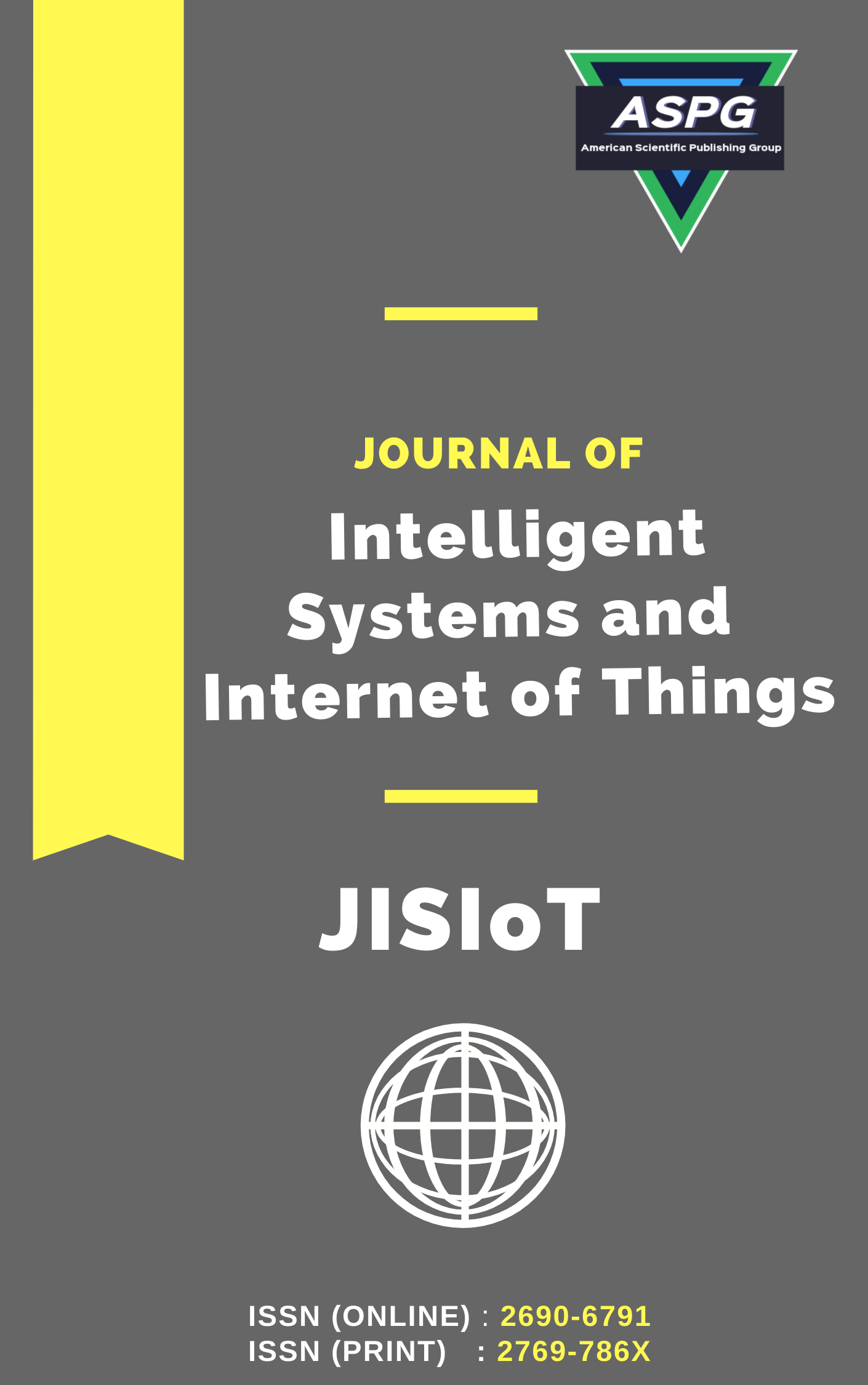

Volume 16 , Issue 2 , PP: 271-285, 2025 | Cite this article as | XML | Html | PDF | Full Length Article
R. Lalitha 1 * , A. V. Senthil Kumar 2
Doi: https://doi.org/10.54216/JISIoT.160220
The primary objective of designing routing protocols for Wireless Sensor Networks (WSNs) is to extend the network lifetime by optimizing the use of the limited battery energy of the sensor nodes. To improve conservation of energy and longevity of the network in WSNs, this study proposes a Cluster-based Chain-Tree Routing Protocol (CCTRP). Integrating tree based chain and cluster routing methods in WSNs is the primary objective of this study. This new CCTRP adopts a sector-based vertical network-partitioning scheme that divides network into sectors and it again vertically partitions the nodes too form various size of clusters. Then, Minimum Spanning Tree (MST) is created based on the kruskal’s Algorithm through a Chain Leader (CL) node serving as the receiver and chain is formed from CLs of last level cluster to Base Station (BS) in each sector. Using the BS, remaining energy and distance to the next CL node, CCTRP determines the Cluster Leader (CL) or Chain CL node in each cluster. For data transport, it also selects the shortest paths. When the energy that remains in the node is ready to be exhausted, the transition is executed according to this protocol. This results in a significant improvement of the average network lifespan. Finally, the CCTRP protocol outperforms the current protocols in terms of network performance, according to the simulation results.
WSN , Routing , Chain based routing , clustering , Vertical network partitioning , Minimum spanning tree
[1] M. N. Mowla, N. Mowla, A. S. Shah, K. Rabie, and T. Shongwe, "Internet of Things and wireless sensor networks for smart agriculture applications—A survey," IEEE Access, vol. 11, pp. 145813-145852, 2023.
[2] A. Fascista, "Toward integrated large-scale environmental monitoring using WSN/UAV/Crowdsensing: A review of applications, signal processing, and future perspectives," Sensors, vol. 22, no. 5, p. 1824, 2022.
[3] M. Navarro, Y. Liang, and X. Zhong, "Energy-efficient and balanced routing in low-power wireless sensor networks for data collection," Ad Hoc Networks, vol. 127, p. 102766, 2022.
[4] A. Shahraki, A. Taherkordi, Ø. Haugen, and F. Eliassen, "A survey and future directions on clustering: From WSNs to IoT and modern networking paradigms," IEEE Trans. Netw. Serv. Manag., vol. 18, no. 2, pp. 2242-2274, 2020.
[5] N. Merabtine, D. Djenouri, and D. E. Zegour, "Towards energy-efficient clustering in wireless sensor networks: A comprehensive review," IEEE Access, vol. 9, pp. 92688-92705, 2021.
[6] M. H. A. Hussain, B. Mokhtar, and M. R. Rizk, "A comparative survey on LEACH successors clustering algorithms for energy-efficient longevity WSNs," Egyptian Informatics Journal, vol. 26, p. 100477, 2024.
[7] S. B. Khan et al., "Artificial intelligence in next-generation networking: Energy efficiency optimization in IoT networks using hybrid LEACH protocol," SN Comput. Sci., vol. 5, no. 5, p. 546, 2024.
[8] Pranesh and S. L. Deshpande, "Tree-based approaches for improving energy efficiency and lifetime of wireless sensor networks (WSN): A survey and future scope for research," in Proc. Inventive Commun. Comput. Technol., pp. 583-590, 2020.
[9] V. R. Krishna, V. Sukanya, and M. A. Hameed, "Optimizing Wireless Sensor Network longevity with hierarchical chain-based routing and vertical network partitioning techniques," Measurement: Sensors, vol. 36, p. 101390, 2024.
[10] M. Savitha and B. Jayanthi, "Novel enhanced power-efficient gathering in sensor information systems (Nepegis) for energy-aware data routing in IoT WSN," Educ. Admin.: Theory Pract., vol. 30, no. 5, pp. 13040-13047, 2024.
[11] F. Bouakkaz and M. Derdour, "Maximizing WSN life using power-efficient grid-chain routing protocol (PEGCP)," Wireless Pers. Commun., vol. 117, no. 2, pp. 1007-1023, 2021.
[12] L. Chan, K. Gomez Chavez, H. Rudolph, and A. Hourani, "Hierarchical routing protocols for wireless sensor network: A comprehensive survey," Wireless Netw., vol. 26, pp. 3291-3314, 2020.
[13] A. K. Maurya, A. Kumar, and N. Kumar, "Improved chain-based cooperative routing protocol in WSN," J. Phys.: Conf. Ser., vol. 1478, no. 1, p. 012017, 2020.
[14] J. Qiao and X. Zhang, "Polar coordinate-based energy-efficient-chain routing in wireless sensor networks using random projection," IEEE Access, vol. 6, pp. 21275-21286, 2018.
[15] A. Aziz, W. Osamy, A. M. Khedr, and A. Salim, "Chain-routing scheme with compressive sensing-based data acquisition for Internet of Things-based wireless sensor networks," IET Netw., vol. 10, no. 2, pp. 43-58, 2021.
[16] S. Firdous, N. Bibi, M. Wahid, and S. Alhazmi, "Efficient clustering-based routing for energy management in wireless sensor network-assisted Internet of Things," Electronics, vol. 11, no. 23, p. 3922, 2022.
[17] Y. Zhang, L. Liu, M. Wang, J. Wu, and H. Huang, "An improved routing protocol for raw data collection in multihop wireless sensor networks," Comput. Commun., vol. 188, pp. 66-80, 2022.
[18] S. M. Altowaijri, "Efficient next-hop selection in multi-hop routing for IoT-enabled wireless sensor networks," Future Internet, vol. 14, no. 2, p. 35, 2022.
[19] B. Han et al., "A novel adaptive cluster-based routing protocol for energy-harvesting wireless sensor networks," Sensors, vol. 22, no. 4, p. 1564, 2022.
[20] A. Somauroo and V. Bassoo, "Energy-efficient genetic algorithm variants of PEGASIS for 3D wireless sensor networks," Appl. Comput. Inf., vol. 19, no. 3/4, pp. 186-208, 2023.
[21] W. B. Heinzelman, A. P. Chandrakasan, and H. Balakrishnan, "An application-specific protocol architecture for wireless microsensor networks," IEEE Trans. Wireless Commun., vol. 1, no. 4, pp. 660-670, 2002.
[22] M. Abo-Zahhad, M. Farrag, A. Ali, and O. Amin, "An energy consumption model for wireless sensor networks," in 5th Int. Conf. Energy Aware Comput. Syst. Appl., pp. 1-4, 2015.